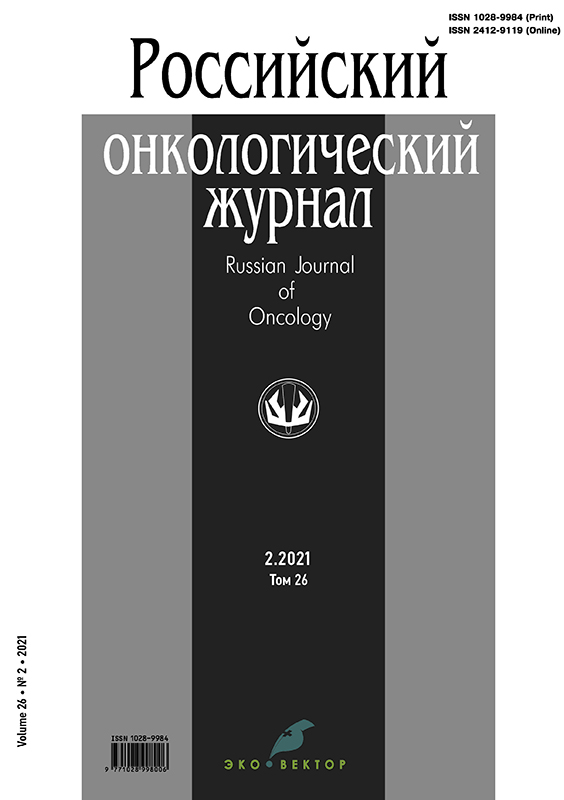Том 26, № 2 (2021)
- Год: 2021
- Выпуск опубликован: 15.04.2021
- Статей: 4
- URL: https://rjonco.com/1028-9984/issue/view/4123
Оригинальные исследования
Фагоцитарная и хемилюминесцентная активность нейтрофилов крови у больных раком мочевого пузыря
Аннотация
Обоснование. Опухолевое микроокружение модулирует (в том числе с помощью метаболитов) функциональную активность нейтрофилов, что способствует перепрограммированию из противоопухолевой активности в проопухолевую.
Цель. Изучение фагоцитарной и хемилюминесцентной активности нейтрофилов у больных раком мочевого пузыря (РМП) при воздействии метаболитов опухолевого микроокружения in vitro.
Методы. Обследовано 37 пациентов с немышечно-инвазивным РМП (T1,а,isN0M0) и 32 здоровых человека в качестве контрольной группы. Выделенные из крови нейтрофилы инкубировались in vitro с лактатом, аденозиндифосфатом (АДФ) и глутаматом. Фагоцитарная активность была исследована методом проточной цитометрии. Интенсивность респираторного взрыва нейтрофилов изучали с помощью хемилюминесцентного анализа.
Результаты. У больных РМП снижены величины фагоцитарного индекса (ФИ) в контрольной пробе (без воздействия метаболитов in vitro) и при воздействии глутамата, в то время как воздействие лактата на клетки вызывает повышение фагоцитарного числа и ФИ. Под влиянием лактата in vitro снижается активность спонтанной и зимозан-индуцированной хемилюминесценции нейтрофилов. АДФ вызывает снижение показателей только спонтанной хемилюминесценции. Под влиянием глутамата понижаются показатели спонтанной и индуцированной хемилюминесценции.
Заключение. Под воздействием лактата и АДФ (продукты опухолевых клеток) стимулируется фагоцитарная активность популяции незрелых нейтрофилов, в составе которых определяются миелоидные супрессорные клетки, ингибирующие противоопухолевый иммунитет. Метаболиты опухолевого микроокружения модулируют активность респираторного взрыва нейтрофилов у больных РМП.
 39-48
39-48


Прогностическое значение количественной оценки содержания макрофагов (CD68+) в перитуморозной зоне светлоклеточного рака почки
Аннотация
Цель. Количественный анализ плотности распределения макрофагов (МФ) в перитуморозной зоне (ПЗ) светлоклеточного рака почки (СРП) и определение взаимосвязи плотности распределения МФ в ПЗ с клинико-морфологическими факторами прогноза и послеоперационной выживаемостью больных.
Материалы и методы. В исследование было включено 52 пациента с СРП, средний возраст больных составлял 56,7±0,8 лет. Макрофаги выявляли в парафиновых срезах иммуногистохимическим методом с помощью моноклональных мышиных антител к CD68 (клон PG-M1, DAKO). Высчитывали среднее количество МФ в ПЗ в 3 полях зрения при увеличении микроскопа х 400 (за ПЗ принимали ткань непосредственно прилежащую к опухоли до условно неизменённой ткани почки).
Результаты. При корреляционном анализе выявлено, что плотность распределения МФ в ПЗ СРП была взаимо- связана: со стадией заболевания (r=0,66; p=0,0001); размером опухолевого узла (r=0,52; p=0,0001); степенью анаплазии по Fuhrman (r=0,80; p=0,0001); наличием метастазов (r=0,62; p=0,0001) и послеоперационной выживаемостью больных (r=0,53; p=0,0001). Не было обнаружено корреляционных взаимосвязей с полом (r=0,007; p=0,62) и возрастом пациентов (r=0,03; p=0,83). При числе МФ в ПЗ <8,8 кумулятивная доля выживших к 5-летнему сроку составляла – 0,70 (70%), а когда число МФ в ПЗ было ≥8,8, то до 5-летнего срока не дожил ни один из пациентов, кумулятивная доля выживших при этом составила 0 (log-rank-test, p=0,000001).
Выводы. Плотность распределения МФ в ПЗ была взаимосвязана с важными клинико-морфологическими параметрами СРП и являлась предиктором прогноза 5-летней послеоперационной выживаемости больных. Количественная оценка числа МФ в ПЗ может быть использована при прогнозировании течения СРП в качестве дополнительного фактора, в совокупности с традиционными классическими факторами прогноза.
 49-56
49-56


Научные обзоры
Эволюция современного представления о раке мочевого пузыря
Аннотация
В обзоре отражены изменения, произошедшие в представлении исследователей рака мочевого пузыря за последние 50 лет. Произведён краткий экскурс в историю исследования, патогенез, этиологию, клиническую значимость уротелиального рака. Рассмотрены главенствующие в данный момент теории патогенеза опухолей уротелия, работы и исследования, на которые они опираются. Затронуты вопросы молекулярного изменения при развитии рака мочевого пузыря, исследования микробиома мочи при онкогенезе.
 57-64
57-64


Краткие сообщения
Онкологической службе Алтайского края – 75 лет. Современные возможности диагностики и лечения онкозаболеваний в Алтайском крае
Аннотация
Формирование и развитие онкологической службы Алтайского края начались одновременно с созданием российской противораковой службы. Именно тогда, в непростое послевоенное время, когда страна остро нуждалась в восстановлении и оздоровлении популяции, приказом Совнаркома СССР «О мероприятиях по улучшению онкологической помощи населению» борьба с онкологическими заболеваниями была возведена в ранг государственной стратегии. Это важнейшее историческое решение послужило катализатором не только технологического развития онкологической службы, но и масштабирования её ключевых достижений, инструментов и алгоритмов работы с населением (профилактика, онкологический учёт и проч.) в региональную онкологическую сеть. В 1946 г. в числе первых в стране онкологический кабинет был открыт и в послевоенном Барнауле.
 65-71
65-71












